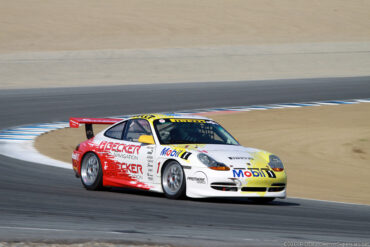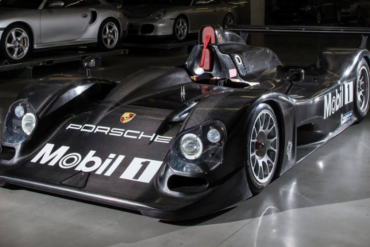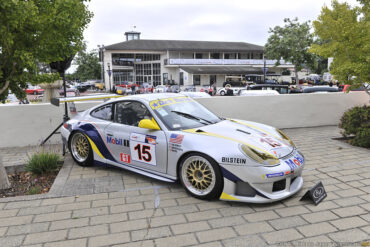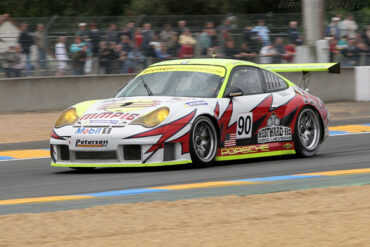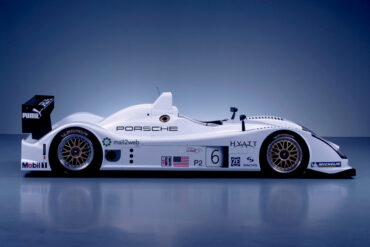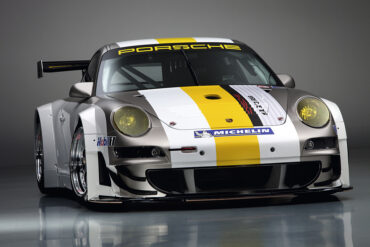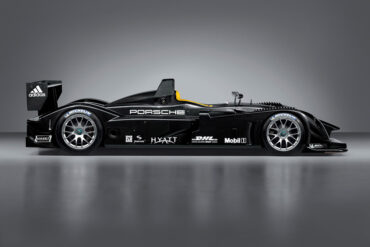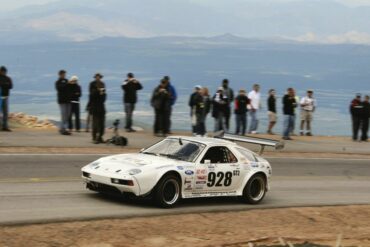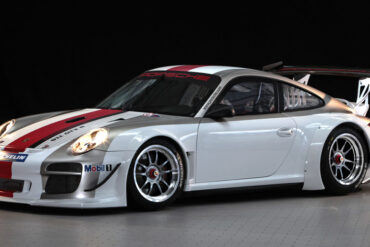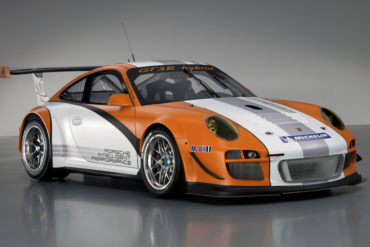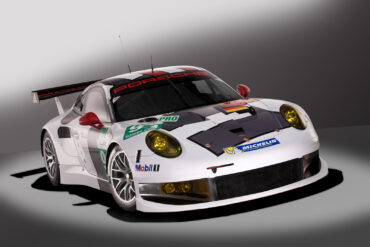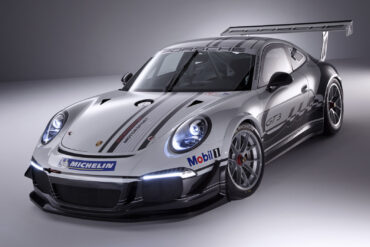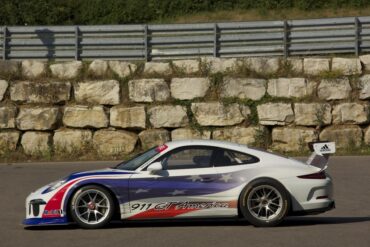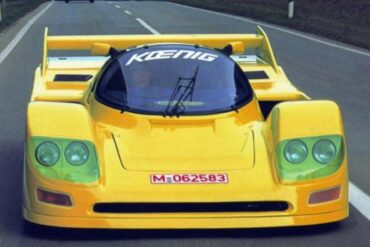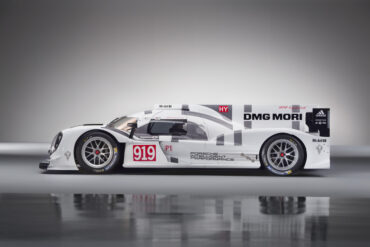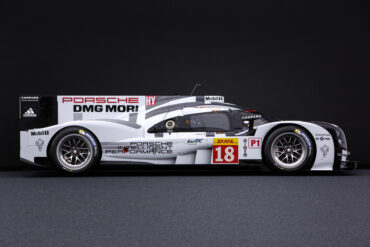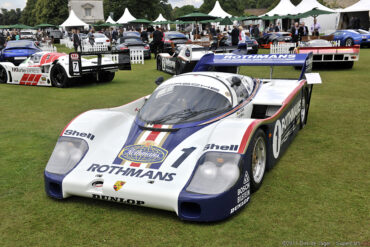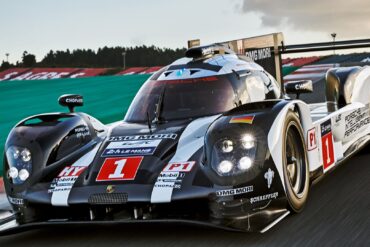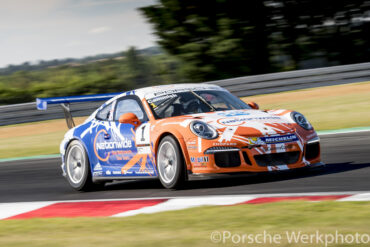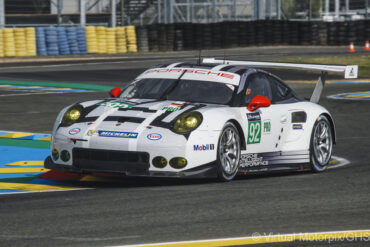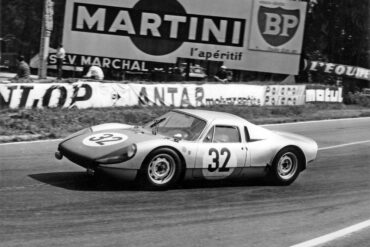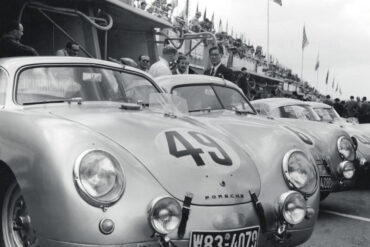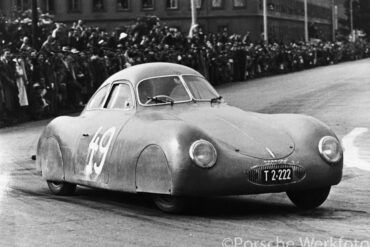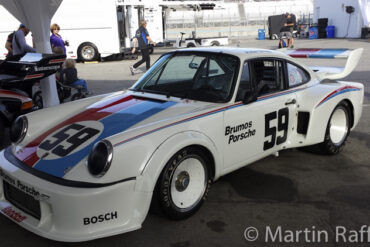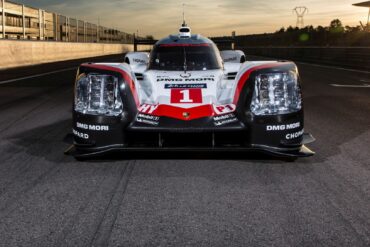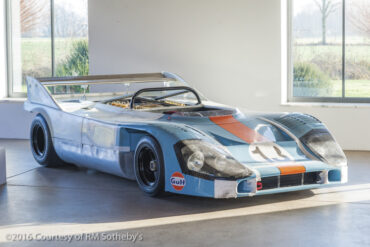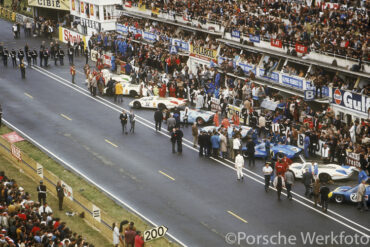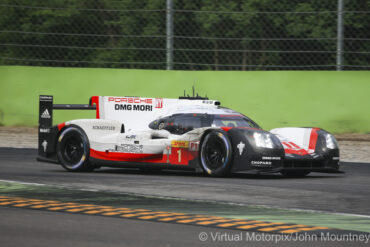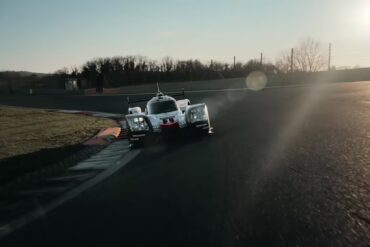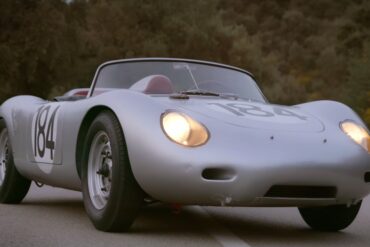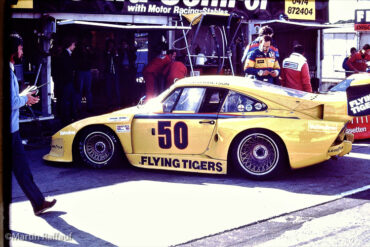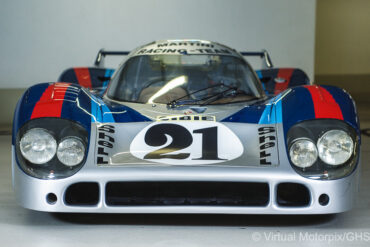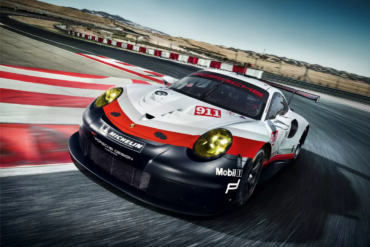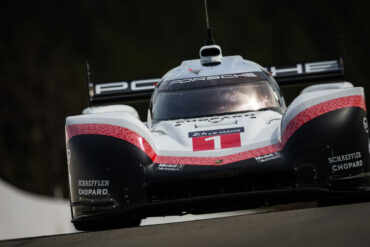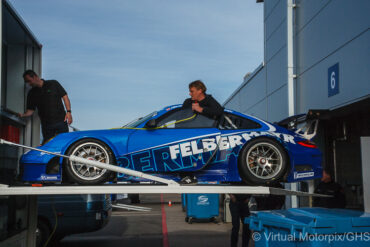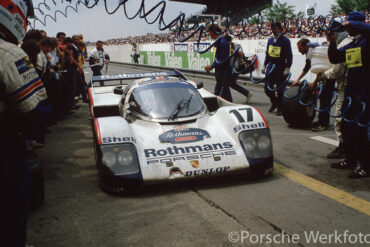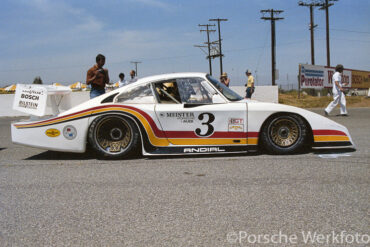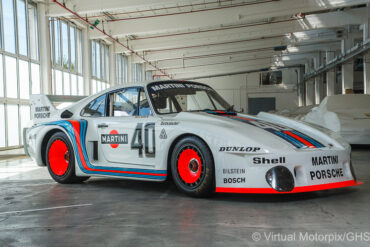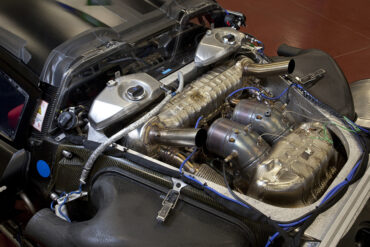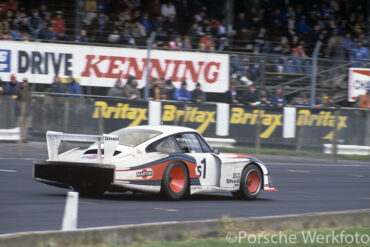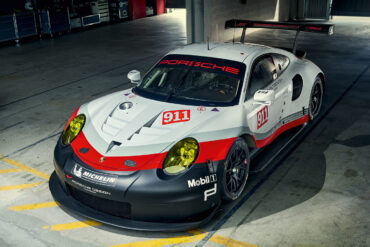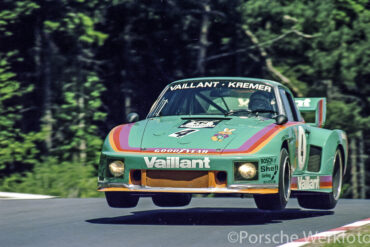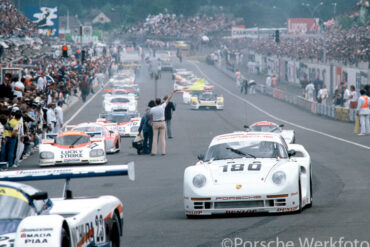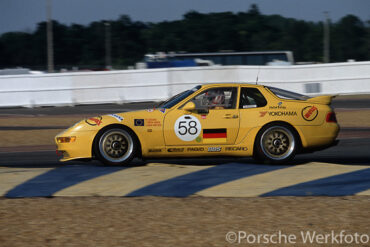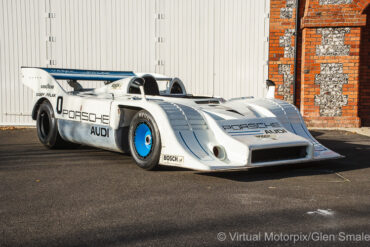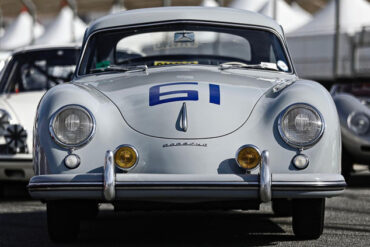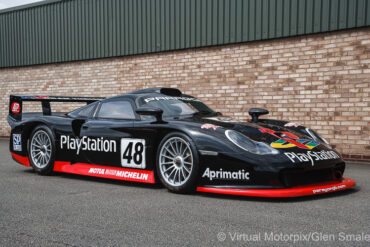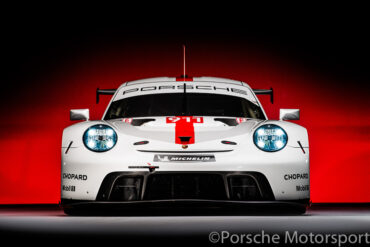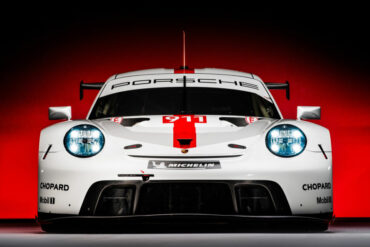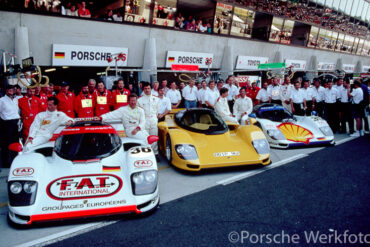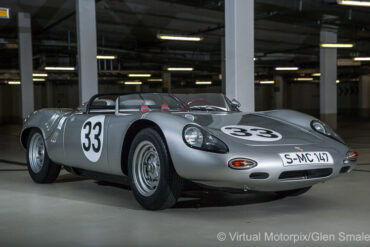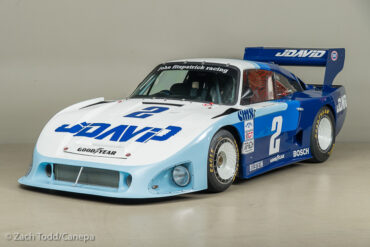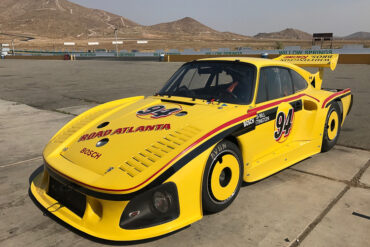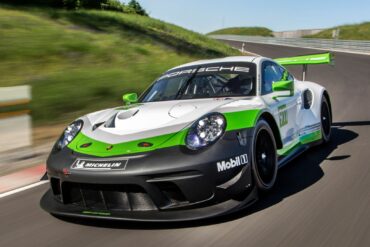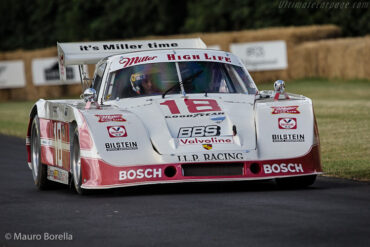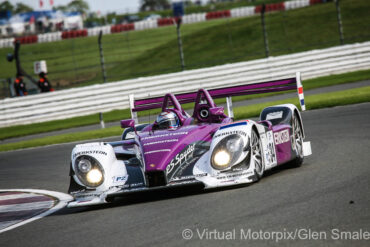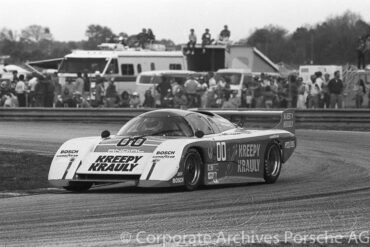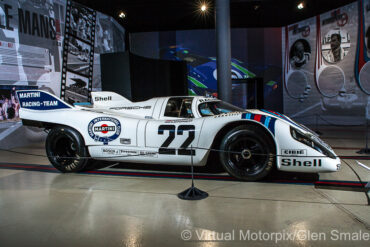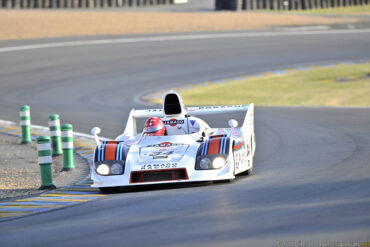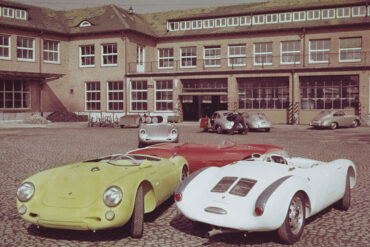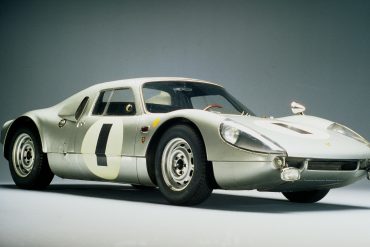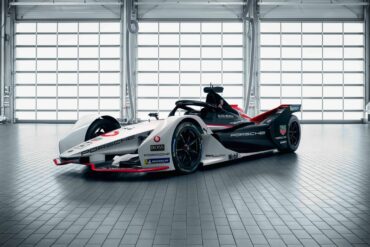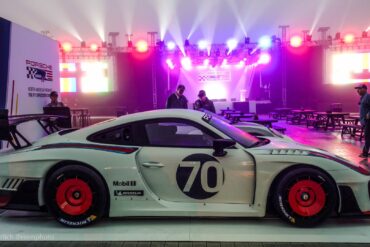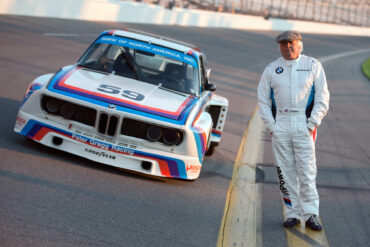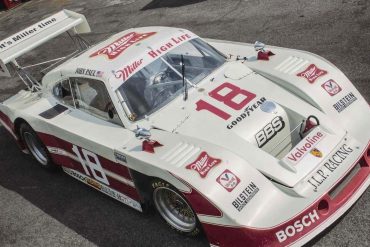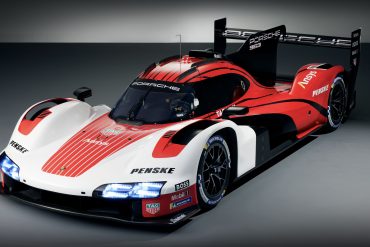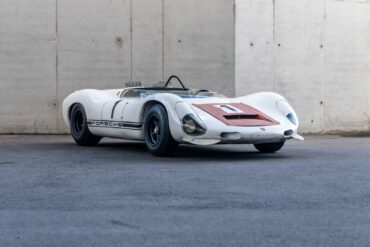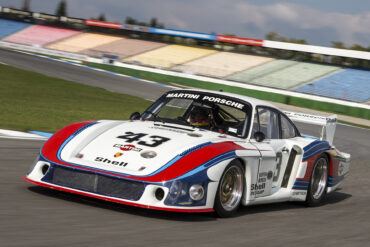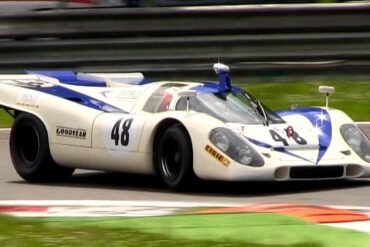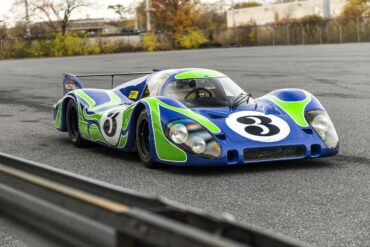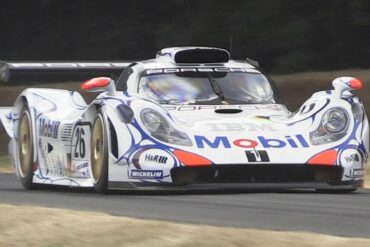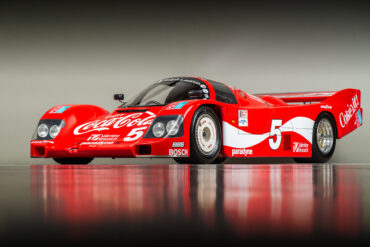The 996 GT3 Cup served as the basis for the 996 GT3 road car, featuring a 3.6 litre engine with 355 hp. For the 1999 season the engine output was increased to 365 hp. For the 2001 season the GT3 Cup received modified aerodynamics including an enlarged rear wing and improved cooling. For 2002, the GT3 Cup received several changes, adopting facelift 996.2 features such as Turbo-style headlights. The new body significantly improves aerodynamics and cooling. Engine output was increased to 380 hp. For 20003 onward, the power was hiked once again, with the engine now pumping out 385 bhp @ 7250 rpm and of torque 288 ft lbs @ 6500 rpm.
The Porsche LMP2000 (also known as the Porsche 9R3) is a Le Mans Prototype racing car that was developed between 1998 and 2000, but never raced. One car was built, and it was designed around a modified version of Porsche's 3.5-litre V10 engine that was originally designed for Formula 1 in 1992. The project was canceled before the car was built, leading to various rumors about the reason for its demise.
The 996 GT3 R was a one-year-only (2000 model year) special of which only 63 were produced. The car took the basic GT3 bones and amplified it for motorsport. The Mezger engine produced over 400 horsepower, while factory-fitted adjustable shock absorbers gave better handling. Most notably, the GT3 R wore carbon-fiber bodywork meant for ultimate light weight in motorsport. The 996 GT3 R was introduced in 1999 as a replacement for the 993 RSR. Before its introduction, it was extensively tested at Weissach and Paul Ricard. In the 2000 FIA GT Championship, the 996 GT3 R was in the N-GT class and won every run. Won the 24-hour race at the Nürburgring.
In the 2000 FIA GT Championship, the 996 GT3 R was the dominant racer in the new N-GT class and won every run. In the same year, the factory-supported Phoenix Racing won the 24-hour race at the Nürburgring. In 2001, the modified version, now called the 996 GT3 RS, was used. The vehicle was not only very successful in its class, it also achieved overall victories. Modelled on the 911 GT3 R, the GT3 RS race cars offered a number of technical improvements, which combine to ensure a racing car with optimal competitiveness. 50 racing cars were produced.
Based on the road-going 996 911 GT3 RS, the GT3 RSR features improvements to its predecessor in all key areas. The vehicle is available in an ACO (Automobile Club de l'Ouest) version for competing in Le Mans and in the American Le Mans Series as well as in a FIA specification. The 911 GT3 RSR features a modified front which improves downforce at the front axle. The 3.6-litre, six-cylinder boxer engine delivers 445 hp at 8,250 revs. Maximum torque is now 405 Nm at 7,200 rpm, with top revs reached at 8,500 (for the FIA specification with two 30.8 mm air restrictors). Race cars never got more exciting than this.
The Porsche RS Spyder, internally called 9R6, exists only thanks to a customer order made in 2004 by Penske Motorsports, a subsidiary of Penske Racing. The 9R6 was built according to the Le Mans Prototype class 2 (LM P2) regulations and to be raced at the American Le Mans Series (ALMS) in USA and Canada. The ALMS was created in the spirit of the Le Mans endurance races, hence the name of the series.
The Porsche 997 GT3 Cup was a series of race cars created by Porsche to enter the Fédération Internationale de l’Automobile (FIA) Group GT3 racing class. Replacing the 996 GT3 Cup, the 997 Cup's 3.6 litre engine is rated at 294 kW (400 PS; 394 hp) and was mated to a six-speed sequential transmission. In 2009, the GT3 Cup received several 997.2 updates including a new 3.8 litre engine with an output of 331 kW (450 PS; 444 hp).
Porsche has announced the introduction of the new 2007 911 GT3 RSR (type 997) for the American Le Mans Series and other world GT racing venues. The latest version of the most successful racing sports car in history is based on the street production model 911 GT3 RS (model year 2007) and was launched in late 2006. The 911 GT3 RSR has wider rear fenders and rear track to improve performance capabilities over its predecessor. The car has also been developed to fit into the 1,225 kg class. The new car is built in accordance with the ACO LMGT2 Regulations and the FIA Article 257.
Following a development year with Penske Motorsports in ALMS, Porsche revealed the final version of their LMP2 contender for the 2007 season. Known as the 'EVO' model, it had a host of upgrades that made it suitable for customer-funded teams to successfully compete. This model dominated the P2 class at events like Le Mans and Sebring. It raced from 2007 till 2010 with strong results across the board.
In 2007, 2008 and 2009 American racing driver Carl Fausett took his specially prepared and supercharged 1978 Porsche 928 to the Pikes Peak International Hill Climb and competed in the Open Division. Fausett placed third in the Open Division in both 2007 and again in 2009, where he was also the fastest 2WD car. At that time, much of the race course was gravel.
To a large extent, the 3.6-litre boxer engine is identical to the power unit used in the Porsche Mobil1 Supercup and the international Carrera Cup championships. Power output has increased by 20 horsepower to now 440 hp (324 kW) at 8,000 rpm. Maximum torque is up by ten Nm to 430 at 7,250 revs per minute. The power increase results from optimised engine electronics and a modified exhaust system. In contrast to the GT3 Cup, the body of the Cup S is not based on the road-going GT3 but on the GT3 RS.
Following the Porsche 911 GT3 Cup, Porsche AG, Stuttgart, is entering yet another racing car in the 2010 motorsport season: The 911 GT3 R will be raced in series based on the international FIA GT3 regulations, thus succeeding the 911 GT3 Cup S. The main focus in developing this new model was on even better drivability and even easier handling. The 911 GT3 R is powered by a four-litre six-cylinder boxer engine delivering maximum output of 480 bhp (353 kW) transmitted to the rear axle by a sequential six-speed dog gearbox.
During the Geneva Motor Show, a Porsche 911 GT3 R with innovative hybrid drive is making its debut. The innovative hybrid technology featured in the car has been developed especially for racing, standing out significantly in its configuration and components from conventional hybrid systems. In this case, electrical front axle drive with two electric motors developing 60 kW each supplements the 480-bhp four-litre flat-six at the rear of the 911 GT3 R Hybrid. Instead of batteries, an electrical flywheel power generator delivers energy to the electric motors.
The Porsche 997 GT3 R Hybrid 2.0 is an update to the 997 GT3 R Hybrid. Compared to its predecessor, which debuted in 2010, the 2011 second-generation hybrid is 20 percent lighter and more efficient without any concession to lap times. While sharing the same paint scheme, the new vehicle is easily identified by its lack of intakes in front of each rear wheel - changes to engine cooling allowed the slats to be dropped and aerodynamic efficiency improved. It gets a traditional race-bred flat six engine. The GT3 R Hybrid has a completely independent second driveline in the front of the chassis, a clever and complex hybrid electric set up that rockets it from standstill to 60 mph in just 2.5 seconds.
As the rules do not permit higher output engines, the engine for the 991 RSR was taken from the 997 GT3 RSR 4.0 and the development work focused on the chassis, body, aerodynamics and the gearbox. A wishbone front suspension replaced the McPherson struts used in 997. A new development was the lightweight gearbox. One of the priorities in the development was the more evenly balanced weight distribution. The centre of gravity was lower, too.
The new Porsche 911 GT3 Cup is powered by a 3.8-litre six-cylinder flat engine. It generates 460 hp (338 kW) at 7,500 revs, surpassing the predecessor by 10 hp. A six-speed dog-type gearbox developed by Porsche Motorsport which is operated via shift paddles at the steering wheel for the first time in a Porsche brand trophy race car transmits the power to the rear axle. The single piece race wheels with centre mount were also new.
The 911 GT America was based on the 991 GT3 Cup. It was built exclusively for the United Sports Car Racing (USRC) series and its GT Daytona class for 2014. While the GT3 Cup had a 3.8-litre engine at the time, the GT America was fitted with a 4.0-litre unit developing 351 kW. The main visual difference is the rear spoiler made to fit the USRC rules. Like the GT3 Cup, the GT America has 380 mm steel brake rotors at the front axle with 6-piston fixed calipers.
1991 Koenig-Specials C62 One of the more notorious tuners is Koenig Specials. As the focus of the company has been...
The Porsche LMP1-H (Le Mans Prototype Class 1, Hybrid) race car featured a hybrid system that consisted of a turbocharged 2.0V4 petrol engine at the rear axle and an electric motor at the front axle. The electric motor/generator unit (MGU) collected the energy from the front axle under braking and the AER exhaust energy recovery system operated on the exhaust gas - a separate turbocharger ran an alternator.
The 2015 season Porsche released a new version of their 919 LMP1 prototype which was reshaped and significantly upgraded to the Premiere class which uses an 8 megajoule hybrid electric system. It follows the 2014 car which had competitive but lackluster year against Audi and Toyota. Combined with a 2 litre, twin turbo V4 gasoline engine is the 8 megajoule lithium-ion battery which powers the front electric engine for a total power output nearing 900 to 1000 bhp.
Based on the 911 GT3 RS production sports car, Porsche has designed a customer sport race car for GT3 series around the world: The 911 GT3 R. In developing the more than 368 kW (500 hp) racing nine-eleven, special attention was paid to lightweight design, better aerodynamic efficiency, reducing consumption, improved handling and optimised safety. The 911 GT3 R features the distinctive double-bubble roof, and the wheelbase which had been lengthened compared to the prior generation.
The third-generation 919 Hybrid (2016 MY) is powered by a turbocharged four-cylinder, two-litre petrol engine delivering almost 500 hp that drives the rear axle. The V4 engine, which is fully load-bearing, is turbocharged and features 4-valves per cylinder, DOHC, a Garrett turbocharger, direct fuel injection and an aluminium cylinder crankcase. In addition, the electric motor delivering more than 400 hp to the front axle. The latter is fed by two energy recovery systems.
Porsche Cayman GT4 Clubsport The power of the Cayman GT4 Clubsport is powered by a 3.8-litre mid-mounted flat engine developing...
Porsche 911 GT3 Cup (2016) The Porsche 911 GT3 Cup is the racing version of the 911 GT3. In 2016,...
The #92 Porsche 911 RSR of Makowiecki/Bamber/Bergmeister negotiates the Ford Chicane during the 2016 Le Mans 24H From the very...
A Porsche 904 Carrera GTS Coupé in 1963 outside the factory in Stuttgart-Zuffenhausen. The early version had a slatted air...
The name Porsche is synonymous with the world’s toughest endurance race, the 24-Hours of Le Mans, boasting an unbroken run...
The rear of the world’s most-produced GT racing car now houses a 4-litre, six-cylinder flat engine for even more drive. Thanks to thoroughbred motorsport technology, the compact engine with direct fuel injection delivers peak performance of 357 kW (485 hp). A range of innovative details also improve efficiency in addition to engine performance, ensuring even better durability of the naturally aspirated engine in racing mode and reduced maintenance costs.
Engineering drawing of the Porsche Type 64 (16 September 1938). Note the provision for two spare wheels in the front...
This is the Peter Gregg car (chassis #930 770 0952) as shown at the Porsche Rennsport 2015. In early 1977,...
According to Porsche, it retained the monocoque from 2016, but 60 to 70% of the 2017 car was new, with the largest alterations being to its aerodynamic demands. This included a major redesign of the front of the 919 Hybrid with wider arches for the front wheels to make it less aerodynamically sensitive from small bits of discarded rubber from the track surface. Porsche remained in the 8 MJ (2.2 kWh) MGU category for the 2017 season. The engine was modified to be lighter and more compact, and Porsche stated that it was its most-efficient ever.
2000MY Porsche 996 GT3 R (chassis #692090) © Coys This Porsche 996 GT3 R is being offered for sale by...
1970 Porsche 917/10 prototype chassis #917/10-001 as offered for sale on 8 February 2017 Mention the name Porsche and motor...
Porsche 911 Carrera RS Sport Lightweight ‘AUI 1500’ as it is today The Porsche 911 Carrera RS 2.7 broke cover...
Porsche 964 Carrera RS 3.6-litre (1992), January 2017 Porsche’s popular 911 model range has evolved hugely over the years, but...
Le Mans 24 Hours, 20/21 June 1964: Porsche 904/8 of Edgar Barth/Herbert Linge before the start of the race The...
Now in its fourth year of competition, the Porsche 919 hybrid continues to be developed into a more efficient racer....
Developed to follow in the steps of its Le Mans winning predecessors: The new 2017 Porsche 919 Hybrid is upon...
In this episode, we get to see a Porsche 718 living strong even after all these years as the story behind...
Porsche 935 chassis no. 009 00030, the Old Warhorse speeds up the hill at the 2015 Goodwood Festival of Speed...
Daytona 24 Hours, 31 January/1 February 1981: Bob Garretson, Bobby Rahal and Brian Redman driving the #9 Porsche 935 (chassis #009...
#21 Martini Porsche 917 LH (chassis #042) was driven by Gerard Larrousse and Vic Elford in the 1971 Le Mans...
Two decades after the different 911 GT1 cars the mid-engined 911 is back! In order to install a proper diffuser under the rear end of the 991, the engine had to make room for it and the engine/transmission unit was rotated 180 degrees. The extended rear diffuser, a top-suspended rear wing and the new side mirrors help to increase downforce with reduced drag. The FIA rules meant no turbo was needed due to power limits, so the normally aspirated 4-litre flat-6 was taken from the 991 GT3 R.
This car was officially called as the 911 GT2 RS Clubsport, but the name is rather misleading. The car was not built for the GT2 racing class which is long extinct and club sport has stood for Porsche club track days while this non-streel-legal car is a real racing car. Finally, the car was based on the 991 GT2 RS, which already had the Clubsport version. So, in order to understand what is what, we call it "991 GT2 RS Clubsport racing version". The 991 GT2 RS engine with 515 kW was powerful enough, so it was not tuned.
With the car retiring after the 2017 LMP WEC season, the Porsche team decided to throw it a truly memorable send-off. Freed from any restrictions brought upon by strict regulations in the class it competed in, Porsche threw out the rulebook and established a new benchmark. Amongst the notable parting gifts was a significant horsepower bump, increasing the turbo V4 to 720 horsepower from 500 horsepower. Additionally, the electric motor received a 10% boost, now generating 440 horsepower. In total this gave the 919 a remarkable 1160 horsepower.
Donington Park Circuit, 11 April 2017: Porsche 911 GT3 RSR (chassis #WP0ZZZ99Z9S799918) is off-loaded It was a clear day in...
Rothmans Porsche 962C (chassis #006) 1987 Le Mans 24 Hour winner photographed at Porsche Museum in Stuttgart, May 2017 The...
Side view of the ANDIAL 935-L ‘Moby Dick’ in the Riverside pit lane 1982 The ANDIAL 935-L ‘Moby Dick’ race...
The 1977 #40 Martini Porsche 935/2.0 Baby (chassis #935 2 001) photographed at the Porsche Museum, Stuttgart, Germany in May...
Corsica Rally, 1967: Vic Elford and David Stone driving a Porsche 911 2.0 R Not a company to stand still...
Porsche 935-78 Moby Dick (chassis 935/78.006 ), photographed at the Porsche Warehouse in May 2017 Group 5 rules offered manufacturers...
Yes, It’s For Sale…. However, the allocation for MY2018 units was already spoken for before this calendar year – all...
Le Mans 24 Hours, 9/10 June 1979: Its a tense time as the lead car, the #41 Numero Reserve Kremer...
Group shot of (from L-R): Porsche 959 Paris-Dakar rally car; 959 road car; 961 race car (1986) The Porsche 961...
1993 Porsche 968 Turbo RS The story of the fabulous 968 Turbo RS, one of Porsche’s sweetest front-engined racers, might...
1973 Vasek Polak Porsche 917/10-018 Cam-Am Spyder driven by Jody Scheckter Jody Scheckter was born in East London on the...
Jägermeister Porsche 934 chassis #930 670 0167 The Jägermeister 934 is one of the most recognisable liveries in the world...
Porsche 911 GT2 RS Clubsport (Type 991, Gen. 2) The new Porsche 911 GT2 RS Clubsport celebrated its world premiere...
On 3 January 2019 the 718 Cayman GT4 Clubsport was unveiled in two variants, Competition and Trackday, with first customer cars delivered to customer teams ahead of the 2019 Roar Before the Rolex 24 Hours at Daytona International Speedway. The race car is powered by a 3.8-litre naturally-aspirated flat-six engine producing 425 PS (419 bhp; 313 kW) at 7,500 rpm and 425 N⋅m (313 lb⋅ft) at 6,600 rpm connected to a 6-speed PDK gearbox. The kerb weight is 1,320 kg (2,910 lb). Both variants feature a welded-in roll cage, a six-point harness and race bucket seat, a selection of body parts made of natural-fibre composite materials and race suspension from the 911 GT3 Cup.
Simeone Foundation Museum – 1970 Porsche 917-043 While diplomats and cartographers may technically show the roads around Le Mans as...
Kim Copperthite watches the Porsche 919 Hybrid Evo during its record run at the Porsche Rennsport Reunion VI, Laguna Seca,...
1997 Porsche 911 GT1-109 photographed in June 2016 Porsche 993 GT1 chassis #109 was one of just nine customer racing...
The new Porsche 911 RSR (2019) What better way to introduce a new race car model, than to do so...
Improving a Car That’s Already Excellent The Porsche 911 RSR is a car that has won more than 20 FIA World...
Le Mans 24 Hours, 16-17 June 2007: Busy grid just before the start of the race Porsche introduced their new...
Le Mans 24 Hours, 14-15 June 1975: Porsche 9083 in the paddock ahead of the race (copyright Yves Ronga) When...
Lined up in the pit lane before the 1994 Le Mans 24-Hours, is from the left: #36 962 Dauer Le...
Kremer Porsche 935 K3 – chassis #930 890 0021 The Porsche 935 was the Stuttgart manufacturer’s answer to the FIA’s...
The year 1974 will be remembered for many different reasons, depending on where you were living in the world at...
1961 Porsche 718 W-RS Spyder ‘Grossmutter’ (chassis #047) photographed at the Porsche Museum, May 2019 The word unique is a...
1981 Porsche Kremer 935 K4 – chassis #K4-01 In the mid-1970s, Porsche developed the 911 for racing, and in the...
Kremer Porsche 935 K3/80 (chassis #0013) In the mid-70s, Porsche developed the 935 model, a race car homologated on the...
1979 Porsche 935 chassis #009 0004 – Willow Springs International Raceway © Robert Graham Junior The phone rang, it was...
This was the fourth version of the 991 RSR - the first two came with the rear engine, then the first mid-engine version was launched (all 4.0-litre) and finally the mid-engined RSR 4.2 with the largest 911 engine ever made. The increase in the engine capacity is a question mark as on production models the capacities are decreased and turbochargers are used. The 991 RSR 4.2 didn't have anything in common with the production cars anymore. No change in terms of power-to-weight ratio.
The GT3 R has always been placed between the GT3 Cup and the very expensive RSR. All the 991.2 racing cars have normally aspirated 4-litre engines. Compared to the 991.1 GT3 R, the 991.2 GT3 R engine offers a broader usable rev range and the engine response is more precise due to 6 throttle butterflies. The roof, front hood and fairing, wheel arches, doors, side and tail sections, rear lid and interior trim are made of carbon-fibre reinforced plastic. Gets new double wishbone suspension.
Porsche 935 JLP-4 at the Goodwood Festival of Speed, 2014 JLP-4 was the final race car in the line of...
Autosport 1000 km, Silverstone, 14 September 2008: In the fifth and final round of the 2008 Le Mans Series season,...
Daytona 24 Hours, 4-5 February 1984: Sarel van der Merwe, Graham Duxbury and Tony Martin drove a fine race to...
Porsche 904/8 (chassis #008) photographed in the Porsche Museum, September 2020 F.A. ‘Butzi’ Porsche, the eldest son of Ferry and...
Molly ready for the Peking to Paris rally in 2007 © David & Julie Harrison She was manufactured in 1958,...
ACO Museum, Le Mans 16 September 2020: As it was the 50th anniversary of Porsche’s first win at Le Mans,...
1966 Porsche 911 2.0-litre – GVB 911D – parked on track at Lodge Corner after practice for the Oulton Park...
Porsche 550 (1953-1956) Introduction Porsche needed a race car to compete in the roadster class, and that’s just what the...
Porsche’s Type 904, officially called the Carrera GTS because Porsche and Peugeot were in dispute over numeric designations with “0” in them, succeeded the RSK Type 718 as the last sports-racing iteration of the 356 series. Developed after Porsche left Formula One in 1962, the 904 (as it soon became popularly known) was also the last full-competition Porsche that could be readily driven on the street. This is the full story.
Spark Racing Technology is responsible for a big part of the Porsche 99X Electric. This is the racing car Porsche fielded in Formula E 2019 season. Maximum performance in qualifying mode? 335 horsepower and 174 mph. Zero to 100 kilometers per hour is doable in 2.8 seconds, and the minimum weight including the driver is rated at 900 kilograms of which the battery is responsible for 385 kilograms. In race and attack modes, the output is restricted to 272 and 320 PS, respectively. The useable battery capacity is 52 kWh while maximum recuperation is rated at 250 kW.
The silhouette is familiar. With weaves of carbon fiber covering almost every external surface, the Porsche 935/19 cuts an unmistakable...
Porsche will only build 30 examples of the Clubsport 25. Mechanically, it's similar to the regular GT2 RS Clubsport. It makes the 691 horsepower from a twin-turbocharged 3.8-liter flat-six. But it gets many, many changes to the exterior and even the cooling system. As you can clearly see, the body has been lengthened, and it has also been widened. The latter is necessary to house the wide, low-offset 18-inch wheels taken from the Porsche 935, though without the aerodynamic covers.
The Porsche Mobil 1 Supercup features the Porsche 911 GT3 Cup, the world’s best-selling race car. For this season, it’s the new generation. 510 hp, optimised intake manifold, electronic gearshift and power steering, fully digital cockpit, larger rear wing, and a double-wishbone front axle. This is a meaningfully upgraded race car. The new 911 GT3 Cup is taking on a great legacy. And it has already proven itself!
Endurance racing legend Brian Redman is once again hosting Targa Sixty Six, a vintage race car gathering he founded in...
There are 935s, and then there are 935s… Although almost a hundred Porsche 935s were built between 1975 and 1984,...
Porsche 963 LMDh – Reviews, Pricing, Specs & Buyers Guide Porsche’s first customer prototype in more than a decade comes with...
With between 200 and 270 horsepower and weight around 420 kg, Porsche’s lightweight 910 Bergspyder was extremely nimble and well-suited...
The 935/78 was the ultimate expression of the 911 factory race car before Porsche officially withdrew from motor sport. Raced...
Have you seen a Porsche 917 in action outside of Le Mans? If not, you’re in for a treat as...
With the aerodynamic instability of the 917 in the 1969, two separate configurations were used in 1970. These were the...
1998 24 Hours of Le Mans winner, the Porsche 911 GT1-98 with chassis number 003, in action at the 2018...
The Porsche 961 was the racing version of the 959 supercar. While the 959 rallye car was also internally called 961,...
Edited by Rex McAfee, Photos © Canepa A Legend is Born: When something great comes along, people scramble at every...


